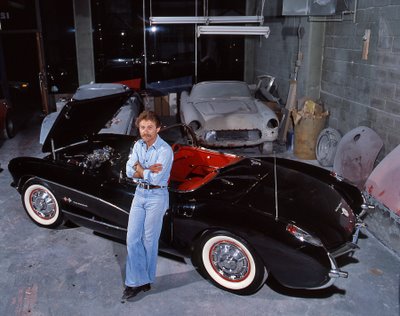Fractals, Nodal Points & The Beauty Of Imperfection
Sunday, July 19, 2009
 |
| William Gibson - Alex Waterhouse-Hayward |
One of the more memorable incidents in Gibson’s 2007 novel Idoru involves a young woman who plans to have a video communication with a woman in Tokyo. She carefully plans what she is going to wear. Once she decides she buys her virtual clothing on the net. Her computer dresses here in these perfect designer clothes. Anybody in the room during the communication would mention something to the effect that the emperor is not wearing clothes. But the woman in Tokyo sees a beautifully dressed woman in an elegantly furnished room.
It is here that Gibson hits on one of his nodal points in which he observes that literal future now. Part of the woman’s computer program lays fractal dust on the surfaces of the virtually real furniture. The dust makes the room look lived-in and authentic.
That scene in Idoru has haunted me and especially now when I look at the photo assignments of my students. Their work is perfect. The imperfect human skin pore has been banished with the use of proprietary (every one of my students has a secret and personal process for this) Photoshop methods involving “healing tools”, “patch tools”, gaussian blurs and other methods like the oddly named "diffuse glow". Photo magazines display marvelous mountain scenes reflected on a pristine lake. The viewer cannot figure out which is the reflection and which is the real scene. The colours are punchy, bright and extremely sharp. Modern computer-designed lenses, even those with plastic elements, are uncommonly sharp. That uncommonly sharp scene can then be further sharpened with the Photoshop sharpening mode.
The above reminds me of the nouveau riche inhabitants of a new development, near ours in Arboledas, called Tecamachalco in the Mexico City I inhabited in the early 70s. These folk had beautifully designed homes and brand new cars. Wood tables marred easily so huge dining room tables were laminated with Formica and then further protected by thick sheets of plate glass. Lamp shades were protected from unsightly dust by being covered by clear plastic protectors. The upholstery of their Ford Galaxies and Mustangs were covered with a thick clear plastic. The purpose of all this was eternal newness.
Anybody who has ever purchased an expensive pair of shoes or a shiny new red bicycle can attest to the disappointment of having someone step on your shoe or that first fall in the red bike and the subsequent scratch of the red paint. If anything the deterioration of the house we live in, the garden we tend, the car we drive all remind us of the corruption and subsequent death of it.
We are temporarily distracted by the perfection and youth of babies and grandchildren. We repair the dent of the car fender. We long ago forgot that the purpose of paint was to stave off the rust of metal. The car will run dent or no dent. In the dawn of computer diagnostics for cars in the late 60s, the white uniformed German technician in my Mexico City VW dealer would show me in a computer print-out, the curves of the four pistons of my Beetle. He would point out how one of the pistons was leaking gas out of the cylinder. Compression was in decline. Time was taking its toll on my shiny new car.
This search for perfection killed Glen Gould’s desire to ever play a concert for and audience. He preferred the pristine environment of the studio. That he then “corrupted” these perfect recordings with his unusual humming perhaps prefigured William Gibson’s fractal dust. As for me I like the unexpected performance of a live performance. Violins make squeaks and when I listen to one of my favourite violinists, Marc Destrubé I enjoy hearing him breathe.
Gibson with his “nodal” ability to see future trends has already predicted one which I think may happily push perfection out of the way. Soon we will see panoramics of polluted lakes in Africa and photographs of women with skin pores and dazzling droopy breasts. Men will soon show of their tire handles and the antique business will be taken over by the former inhabitants of Tecamachalco who by now have discovered the wonders of rust, marred wooden tables and furniture and the beauty of decaying plants and imperfect and aging bodies.
The second photo here is a picture I took of Norm Necemer with his original everything (including paint) fuel injected Corvette. I took the photo around 1983. I am sure that Necemer probably still owns the car and it probably is beautifully looking worse for wear.

Now if I could only make my students understand the beauty of imperfection.






